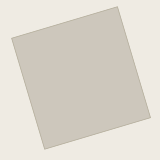Buildings
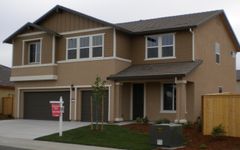
|
| Description |
| Used to describe many different sorts of buildings, including houses, factories and ruined buildings. |
| Tags |
|
|
The definition of "building" is not straightforward. The OpenStreetMap definition is quite wide and includes not only objects considered as buildings by strict definitions but also building=static_caravan, building=houseboat and may include at least some building=storage_tank. There's also no definition when something is a building=tower or man_made=tower (see discussion).
Tagging


building=apartments not building=church
building:use=apartments building=church would be a correct tagging hereA single building outline should be created for each building, which may relate to a single detached property, or to a row of individual terraced houses. It is, however, in the case of terraced houses better to create a series of linked outlines which share some nodes at the boundary to identify each distinct building.
In addition, outlines can either be simplified shapes or very detailed outlines which conform accurately to the shape of the building. It is not uncommon for buildings to initially be described as simple group outlines, later be improved with more detailed outlines and to be split into individual properties.
The most basic use of the tag is building=yes which means any kind of building, or you use a value that describes the building typology, for example building=house, building=hut, building=garage, building=school. See building=* for a more complete list of options, have a look at what is actually used and feel free to make up new values that fit into the existing scheme. Please be aware that building tags are always about the building itself, not the current building usage or its user. This allows for representing more complex situations like a church in an apartment building (building=apartments) or an apartment in a building once erected as a church (building=church).
For adding addresses, have a look at addr=*.
Entrances to buildings can be tagged on nodes on the building outline with entrance=* and potentially access=*. A building entrance can be connected to a description of the footpath access to the entrance by highway=footway and highway=steps etc. In some cases, entrances can have individual postal addresses.
Mentionable usage
There are structures tagged as buildings which are missing a foundation or are even moveable. For example, many mappers are using the key building=* to describe moveable objects and buildings for example building=static_caravan, building=houseboat or trailers. While houseboats (often self-propelled), ships (for example museum or theatre ships) or docks may be moved once, there are also building=floating_homes which are built on floating logs and do not get moved. Some mappers are additionally using floating=yes to indicate this property.
Differing from the ideal of mapping the outline of a building on the ground, many objects with building=* include parts of buildings (for example constructed on piers) which are only covering areas. building=roof and building=bridge even describe buildings which have, except its piers, no outline on the ground. The same holds for underground buildings like building=cellar or those building types which are tagged with location=underground.
Don't tag for the renderer
- For more details on this topic, see Tagging for the renderer.
Some mappers are trying to modify OSM data to be rendered (e.g. by OSM Carto) in a way to fit their wishes by creatively reinterpreting some existing tags.
Please map all attributes as close to the reality as possible with the available data. Make use of the descriptions for the tags at the referring wikipage. Use the existing values by its definition at the wiki and choose the best fitting pair of key and value. If there is no fitting tag and no more generic tag, you may find some uncommented already used tags at taginfo. If all of this does not suffice, you may better create a new tagging and document it at the wiki.
Here are some negative examples in context to buildings.
- tagging of non-existing
amenity=*to emphasize the building at the rendered picture - modify/omit tagging due to dissatisfaction (e.g. café/restaurant)
- building parts as distinct objects to structure the rendered picture
- deleting/moving objects to obtain a (nicer) placement of the icon
- tagging e.g. statues, bridge piers, gravestones or sockets as buildings to make them visible on the map. This can be counterproductive even for 3D-Mapping.
Such manipulations damage not only the OSM, but also they are needless, because their effect is usually limited to a single renderer, which will be probably modified soon.
If there are substantial rendering errors of correct data, please contact the developers of the renderers directly.
How to map
If the building has an interior courtyard, then use a multipolygon relation to ensure that the courtyard is not rendered as part of the building.
Consider adding house numbers nodes to buildings with tags in addr:*=*-namespace:
entrance=yes(if you know where the entrance is)addr:street=*addr:housenumber=*addr:postcode=*addr:city=*addr:country=*- (more values and detailed information here: key:addr)
OSM Inspector is also able to help in checking these tags
In JOSM
- As a lot of buildings are rectangular, you can draw a rough rectangle, and then orthogonalize it in JOSM with the hotkey Q. Pressing Q on a selection sets all the angles in the selection to be 90°. Please be aware that not all buildings are orthogonal, and sometimes it is better to keep an odd looking polygon instead of making a curved shape rectangular.
- For people who changed projection in JOSM from default – JOSM orthogonalizes the projected map, so make sure you are using a conformal projection (one that preserves angles) like Mercator during your editing (otherwise if you use for example unprojected WGS84 while orthogonalizing, objects will be ended up distorted in the database).
- JOSM/Plugins/BuildingsTools makes mapping of buildings a lot more convenient (hotkey B). This works best for buildings with four nodes.
- JOSM/Plugins/Terracer is for quickly mapping a row of terraced houses.
In Potlatch
In Potlatch, you can add several buildings quickly, especially in residential areas by tracing the building with one hand with the mouse and then with the other hand pressing the 'R' key to add the properties of the previously selected building. Add the source, building tag and whatever other tag you want on the first building, then copy it to the other buildings.
Some ways to get the outline of the building
- Aerial photographs (e.g. Bing). There are also some tips and tricks for roof modelling.
- Observations from street level, drawing a sketch, or even taking measurements
- Walking around the edge of the building, taking a GPS trace. Good enough for big buildings (e.g. a stadium) but walls normally reflect the GPS signal, causing the trace to be offset a significant distance away from the building.
- French Cadastre
3D
Use the Simple 3D buildings that is already implemented in some tools and offers backwards compatibility with previous approaches.
Indoor
Simple Indoor Tagging is used for tagging indoor features.
Proposals
Active
- The levels of detail (LOD) and involved tags used for 3D modelling are described here: Simple 3D Buildings V1.
Inactive
- Proposal:Building – original proposal, which mentions various other ideas
- Proposal:Building attributes – attributes proposal, cancelled
- Relations/Proposed/Buildings – (to group buildings and other related things together)
- Proposal:campus building
- Proposal:building=kindergarten – kindergarten buildings
- Proposal:Riding hall – riding hall (for horse riding)
- Proposal:Sports hall – sports hall buildings (gyms)
- Proposal:Student accommodation building – looking for alternative to
building=dormitory
Examples
-
Current rendering of a building
Values
Building
This is used to identify individual buildings or groups of connected buildings. See the page Buildings for further details on the usage of this tag and man_made=* for tagging of various other structures. The building tags are intended for the physical description of a building. For functions in the building (e.g. police station, church, townhall, museum) you should add object with tags like amenity=*, tourism=*, shop=* etc must exist.
For example mapping building=supermarket is not enough to mark place as having an active supermarket shop, it just marks that building has form typical for supermarket buildings. shop=supermarket must be mapped to indicate an active supermarket shop. On the other hand shop=*/amenity=* is not indicating building by itself, building must be mapped with building=* tag.
| Key | Value | Comment | Photo |
|---|---|---|---|
Accommodation | |||
| building | apartments | A building arranged into individual dwellings, often on separate floors. May also have retail outlets on the ground floor. |  |
| building | barracks | Buildings built to house military personnel or laborers. |  |
| building | bungalow | A single-storey detached small house, Dacha. |  |
| building | cabin | A cabin is a small, roughly built house usually with a wood exterior and typically found in rural areas. |  |
| building | detached | A detached house, a free-standing residential building usually housing a single family. |  |
| building | annexe | An annexe is a small self contained apartments, collages, or small residential building on the same property as the main residential unit. |  |
| building | dormitory | A shared building intended for college/university students (not a share room for multiple occupants as implied by the term in British English). Alternatively, use building=residential plus residential=university and loose the information that it is for students.
|
 |
| building | farm | A residential building on a farm (farmhouse). For other buildings see below building=farm_auxiliary, building=barn, … If in your country farmhouse looks same as general residential house then you can tag as building=house as well. See also landuse=farmyard for the surrounding area
|
 |
| building | ger | A permanent or seasonal round yurt or ger. |  |
| building | hotel | A building designed with separate rooms available for overnight accommodation. Normally used in conjunction with tourism=hotel for the hotel grounds including recreation areas and parking.
|
 |
| building | house | A dwelling unit inhabited by a single household (a family or small group sharing facilities such as a kitchen). Houses forming half of a semi-detached pair, or one of a row of terraced houses, should share at least two nodes with joined neighbours, thereby defining the party wall between the properties. |  |
| building | houseboat | A boat used primarily as a home |  |
| building | residential | A general tag for a building used primarily for residential purposes. Where additional detail is available consider using 'apartments', 'terrace', 'house', 'detached' or 'semidetached_house'. |  |
| building | semidetached_house | A residential house that shares a common wall with another on one side. Typically called a "duplex" in American English. |  |
| building | static_caravan | A mobile home (semi)permanently left on a single site |  |
| building | stilt_house | A building raised on piles over the surface of the soil or a body of water |  |
| building | terrace | A single way used to define the outline of a linear row of residential dwellings, each of which normally has its own entrance, which form a terrace ("row-house" or "townhouse" in North American English). Consider defining each dwelling separately using 'house'. |  |
| building | tree_house | An accommodation, often designed as a small hut, sometimes also as a room or small apartment. Built on tree posts or on a natural tree. A tree house has no contact with the ground. Access via ladders, stairs or bridgeways. | 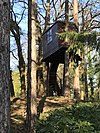 |
| building | trullo | A stone hut with a conical roof. |  |
Commercial | |||
| building | commercial | A building for non-specific commercial activities, not necessarily an office building. Consider tagging the surrounding area using landuse=commercial if there is such use. Use 'retail' if the building consists primarily of shops.
|
 |
| building | industrial | A building for industrial purposes. Use warehouse if the purpose is known to be primarily for storage/distribution. Consider using landuse=industrial for the surrounding area and appropriate tags like man_made=works to describe the industrial activity.
|
 |
| building | kiosk | A small one-room retail building. |  |
| building | office | An office building. Use office=* where applicable for the business(es) that use the building. Consider tagging the surrounding area using landuse=commercial if it applies. Prefer landuse=retail if the building consists primarily of shops.
|
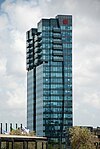 |
| building | retail | A building primarily used for selling goods that are sold to the public; use shop=* to identify the sort of goods sold or an appropriate amenity=* (pub, cafe, restaurant, etc.). Consider use landuse=retail for the surrounding area.
|
 |
| building | supermarket | A building constructed to house a self-service large-area store. |  |
| building | warehouse | A building primarily intended for the storage or goods or as part of a distribution system. |  |
Religious | |||
| building | religious | Unspecific building related to religion. Prefer more specific values if possible. |  |
| building | cathedral | A building that was built as a cathedral. Used in conjunction with amenity=place_of_worship, religion=*, denomination=* and landuse=religious for the cathedral grounds where it is in current use.
|
 |
| building | chapel | A building that was built as a chapel. Used in conjunction with amenity=place_of_worship, religion=*, denomination=* and landuse=religious for the chapel grounds where it is in current use.
|
 |
| building | church | A building that was built as a church. Used in conjunction with amenity=place_of_worship, religion=* , denomination=* and landuse=religious for the church grounds where it is in current use.
|
 |
| building | kingdom_hall | A building that was built as a amenity=place_of_worship, religion=christian, denomination=jehovahs_witness and landuse=religious for the grounds where it is in current use.
|
 |
| building | monastery | A building constructed as amenity=monastery, for the grounds of a former monastery, have a look at historic=monastery
|
 |
| building | mosque | A building errected as mosque. Used in conjunction with amenity=place_of_worship, religion=*, denomination=* and landuse=religious for the grounds where it is in current use.
|
 |
| building | presbytery | A building where priests live and work. |  |
| building | shrine | A building that was built as a shrine. Used in conjunction with amenity=place_of_worship, religion=*, denomination=* and landuse=religious for the grounds where it is in current use. Small structures should consider historic=wayside_shrine.
|
 |
| building | synagogue | A building that was built as a synagogue. Used in conjunction with amenity=place_of_worship, religion=*, denomination=* and landuse=religious for the grounds where it is in current use.
|
 |
| building | temple | A building that was built as a temple. Used in conjunction with amenity=place_of_worship, religion=*, denomination=* and landuse=religious for the grounds where it is in current use.
|
 |
Civic/amenity | |||
| building | bakehouse | A building that was built as a bakehouse (i.e. for baking bread). Often used in conjunction with another node amenity=baking_oven and oven=wood_fired.
|
 |
| building | bridge | A building used as a bridge (skyway). To map a gatehouse use building=gatehouse. See also bridge=yes for highway=*. Don't use this tag just for marking bridges (their outlines). For such purposes use man_made=bridge.
|
 |
| building | civic | A generic tag for a building created to house some civic amenity, for example amenity=community_centre, amenity=library, amenity=toilets, leisure=sports_centre, leisure=swimming_pool, amenity=townhall etc. Use amenity=* or leisure=* etc. to provide further details. See building=public and more specific tags like building=library as well.
|
 |
| building | clock_tower | Clock towers are very high towers, visible from its surroundings, usually in central parts of town and squares, housing a turret clock with one or more clock faces, most often four. They are freestanding structures but can also be adjoined or located on top of another building. |  |
| building | college | A college building. Use amenity=college on the whole college area to represent the college as an institution.
|
 |
| building | fire_station | A building constructed as fire station, i.e. to house fire fighting equipment and officers, regardless of current use. Add amenity=fire_station on the grounds for an active fire station.
|
 |
| building | government | For government buildings in general, including municipal, provincial and divisional secretaries, government agencies and departments, town halls, (regional) parliaments and court houses. |  |
| building | gatehouse | An entry control point building, spanning over a highway that enters a city or compound. |  |
| building | hospital | A building errected for a hospital. Use amenity=hospital for the hospital grounds.
|
 |
| building | kindergarten | For any generic kindergarten buildings. Buildings for specific uses (sports halls etc.) should be tagged for their purpose. If there is currently a kindergarten in the building, use amenity=kindergarten on the perimeter of the kindergarten grounds.
|
 |
| building | museum | A building which was designed as a museum. |  |
| building | public | A building constructed as accessible to the general public (a town hall, police station, court house, etc.). |  |
| building | school | A building errected as school. Buildings for specific uses (sports halls etc.) should be tagged for their purpose. If there is currently a school, use amenity=school on the perimeter of the school grounds.
|
 |
| building | toilets | A toilet block. |  |
| building | train_station | A building constructed to be a train station building, including buildings that are abandoned and used nowadays for a different purpose. |  |
| building | transportation | A building related to public transport. You will probably want to tag it with proper transport related tag as well, such as public_transport=station. Note that there is a special tag for train station buildings - building=train_station.
|
 |
| building | university | A university building. Use amenity=university for the university as an institution.
|
 |
Agricultural/plant production | |||
| building | barn | An agricultural building that can be used for storage and as a covered workplace. |  |
| building | conservatory | A building or room having glass or tarpaulin roofing and walls used as an indoor garden or a sunroom (winter garden). |  |
| building | cowshed | A cowshed (cow barn, cow house) is a building for housing cows, usually found on farms. |  |
| building | farm_auxiliary | A building on a farm that is not a dwelling (use 'farm' or 'house' for the farm house). |  |
| building | greenhouse | A greenhouse is a glass or plastic covered building used to grow plants. Use landuse=greenhouse_horticulture for an area containing multiple greenhouses
|
 |
| building | slurry_tank | A circular building built to hold a liquid mix of primarily animal excreta (also known as slurry). |  |
| building | stable | A building constructed as a stable for horses. |  |
| building | sty | A sty (pigsty, pig ark, pig-shed) is a building for raising domestic pigs, usually found on farms. |  |
| building | livestock | A building for housing/rising other livestock (apart from cows, horses or pigs covered above), or when the livestock changes. | |
Sports | |||
| building | grandstand | The main stand, usually roofed, commanding the best view for spectators at racecourses or sports grounds. |  |
| building | pavilion | A sports pavilion usually with changing rooms, storage areas and possibly an space for functions & events. Avoid using this term for other structures called pavilions by architects (see |
 |
| building | riding_hall | A building that was built as a riding hall. |  |
| building | sports_hall | A building that was built as a sports hall. |  |
| building | sports_centre | A building that was built as a sports centre. |  |
| building | stadium | A building constructed to be a stadium building, including buildings that are abandoned and used nowadays for a different purpose. |  |
Storage | |||
| building | allotment_house | A small outbuilding for short visits in a allotment garden. | |
| building | boathouse | A boathouse is a building used for the storage of boats. |  |
| building | hangar | A hangar is a building used for the storage of airplanes, helicopters or space-craft. Consider adding aeroway=hangar, when appropriate.
|
 |
| building | hut | A hut is a small and crude shelter. Note that this word has two meanings - it may be synonym of building=shed, it may be a residential building of low quality.
|
 |
| building | shed | A shed is a simple, single-storey structure that is used for storage, hobbies, or as a workshop. |  |
Cars | |||
| building | carport | A carport is a covered structure used to offer limited protection to vehicles, primarily cars, from the elements. Unlike most structures a carport does not have four walls, and usually has one or two. | 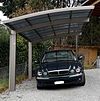 |
| building | garage | A garage is a building suitable for the storage of one or possibly more motor vehicle or similar. See building=garages for larger shared buildings. For an aircraft garage, see building=hangar.
|
 |
| building | garages | A building that consists of a number of discrete storage spaces for different owners/tenants. See also building=garage.
|
 |
| building | parking | Structure purpose-built for parking cars. |  |
Power/technical buildings | |||
| building | digester | A digester is a bioreactor for the production of biogas from biomass. |  |
| building | service | Service building usually is a small unmanned building with certain machinery (like pumps or transformers). |  |
| building | tech_cab | Small prefabricated cabin structures for the air-conditioned accommodation of different technology. |  |
| building | transformer_tower | A transformer tower is a characteristic tall building comprising a distribution transformer and constructed to connect directly to a medium voltage overhead power line. Quite often the power line has since been undergrounded but the building may still serve as a substation. If the building is still in use as a substation it should additionally be tagged as power=substation + substation=minor_distribution.
|
 |
| building | water_tower | A water tower. |  |
| building | storage_tank | Storage tanks are containers that hold liquids |  |
| building | silo | A silo is a building for storing bulk materials |  |
Other buildings | |||
| building | beach_hut | A small, usually wooden, and often brightly coloured cabin or shelter above the high tide mark on popular bathing beaches. |  |
| building | bunker | A hardened military building. Also use military=bunker.
|
 |
| building | castle | A building constructed as a castle. Can be further specified with historic=castle + castle_type=*.
|
 |
| building | construction | Used for buildings under construction. Use construction=* to hold the value for the completed building.
|
 |
| building | container | For a container used as a permanent building. Do not map containers placed temporarily, for example used in shipping or construction. |  |
| building | guardhouse | Poste de garde. |  |
| building | military | A military building. Also use military=*.
|
|
| building | outbuilding | A less important building near to and on the same piece of land as a larger building. |  |
| building | pagoda | A building constructed as a pagoda. |  |
| building | quonset_hut | A lightweight prefabricated structure in the shape of a semicircle. |  |
| building | roof | A structure that consists of a roof with open sides, such as a rain shelter, and also gas stations |  |
| building | ruins | Frequently used for a house or other building that is abandoned and in poor repair. However, some believe this usage is incorrect, and the tag should only be used for buildings constructed as fake ruins (for example sham ruins in an English landscape garden). See also lifecycle tagging. |  |
| building | ship | A decommissioned ship/submarine which stays in one place. |  |
| building | tent | For a permanently placed tent. Do not map tents placed temporarily. |  |
| building | tower | A tower-building. Best combined with tower:type=*. See also man_made=tower for a tag with a similar definition.
|
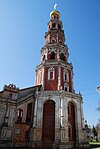 |
| building | triumphal_arch | A free-standing monumental structure in the shape of an archway with one or more arched passageways. |  |
| building | windmill | A building constructed as a traditional windmill, historically used to mill grain with wind power. | 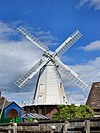 |
| building | yes | Use this value where it is not possible to determine a more specific value. | |
| building | user defined | All commonly used values according to Taginfo, generally building types | |
Additional attributes
| Key | Value | Element | Comment | Photo |
|---|---|---|---|---|
| building:architecture | <architectural style> | Architectural style of a building |  | |
| building:colour | <RGB hex triplet> | <W3C colour name> | Indicates colour of the building |  | |
| building:fireproof | yes | no | Fire-resistance information. | ||
| building:flats | <number> | The number of residential units (flats, apartments) in an apartment building (building=apartments), residential building (building=residential), house (building=house), detached house (building=detached) or similar building. | ||
| building:levels | <number> | The number of visible levels (floors) in the building as used in the Simple 3D buildings scheme |  | |
| building:material | <material type> | Outer material for the building façade |  | |
| building:min_level | <number> | For describing number of values, "filling" space between ground level and bottom level of building or part of building |  | |
| building:part | As building | To mark a part of a building, which has attributes, different from such ones at other parts | 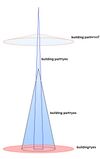 | |
| building:soft_storey | yes | no | reinforced | A building where any one level is significantly more flexible (less stiff) than those above and below it | ||
| construction_date | <date> | The (approximated) date when the building was finished. |  | |
| entrance | yes | main | exit | service | emergency | An entrance in a building. Replaces the deprecated tag building=entrance.
|
 | |
| height | <number> | The height of the building in meters. | 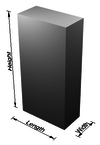 | |
| max_level | <number> | Maximum indoor level (floor) in the building as used in the Simple Indoor Tagging scheme | ||
| min_level | <number> | Minimum indoor level (floor) in the building as used in the Simple Indoor Tagging scheme | ||
| non_existent_levels | <number> | List of indoor levels (floors) that do not exists in the building as used in the Simple Indoor Tagging scheme | ||
| start_date | <date> | The (approximated) date when the building was finished. |  |
This table is a wiki template with a default description in English. Editable here.
Mapping Points of Interest (POIs)
Note that building=* values are not indicating by itself what is currently in the buildings. For example building=retail may contain no shops – it may be instead abandoned and tagged with abandoned=yes, vacant or used as a storage building by another shop.
To mark shops object with shop=* is needed. For buildings containing a single shop or other POI it is quite frequent to place both on the same object. But it is also possible and in some ways preferable to map building=* areas and POI as a separate node or area[1].
See also
shop=*– to indicate that the building is used as a specific shopamenity=*– to describe what the building is used for, for example: school, theatre, bank, ...entrance=*– to mark the entrances to the buildingman_made=courtyard– proposed tag for courtyardsarchitect=*– to indicate the architect of a buildingbuilding:condition=*– for the condition of the buildingruins=*– for ruins of buildingsabandoned=yesadded as a property – for a building which has been abandoned by its owner and is no longer maintainedstart_date=*– the year of construction

